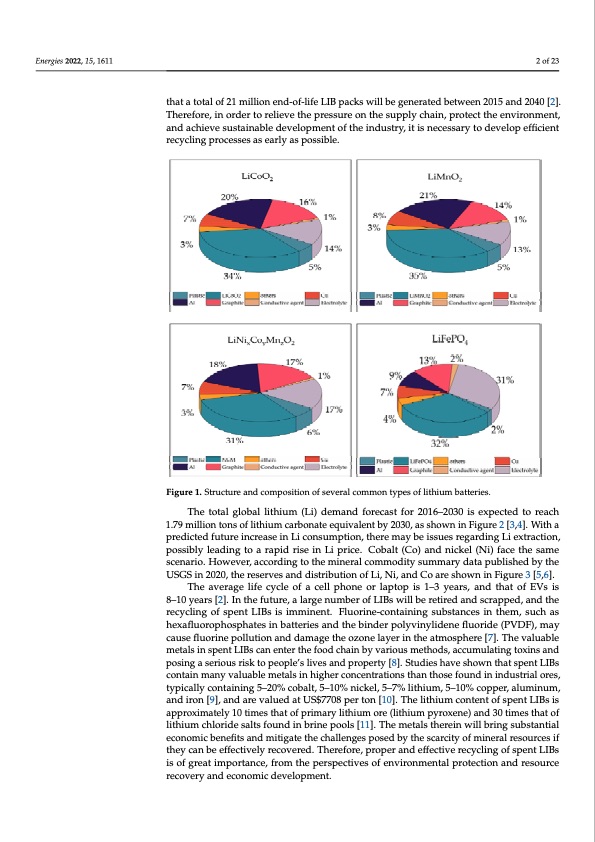
PDF Publication Title:
Text from PDF Page: 002
Energies 2022, 15, 1611 2 of 23 that a total of 21 million end-of-life LIB packs will be generated between 2015 and 2040 [2]. Therefore, in order to relieve the pressure on the supply chain, protect the environment, Energies 2022, 14, x FOR PEER REVIEW 2 of 24 and achieve sustainable development of the industry, it is necessary to develop efficient recycling processes as early as possible. Figure 1. Structure and composition of several common types of lithium batteries. Figure 1. Structure and composition of several common types of lithium batteries. TFhroemto2ta0l15gltob2a0l4l0i,ththiuempr(oLdiu) cdtieomnaonfdLIfBosrefcoarsetlefoctrri2c0v1e6h–i2c0le3s0ciosueldxprecatcehd0t.3o3rteoac4h 1m.7i9llmioinllitonsto[1n]s, owfhlitchiuwmoucladrbroainsaetecoenqcueirvnaslefnort bthye2r0e3s0o,uarsceshsouwppnliyncFhiagiunr.eIt2is[3p,4r]e.dWicittehda ptrheadtiactteodtafluotufr2e1inmcirleliaosneeindL-iocf-olnifseuLmIBptpioanck,sthweriellmbeaygebneeirsastuedesbretgwaerednin2g0L15ieaxntdra2c0ti4o0n, p[o2]s.siTblhyerlefaodrien,gintooardraepridtorirseliienveLitphreicpe.reCssoubraelto(nCot)heansdunpipclkyelc(hNain),fapcreothecetsathmee secnevniarroinom.Henotw,eavnedr,achcioervdeinsgustotatinhaebmleindeervaellcoopmmenotdoitfytshuemimndaursytrdya,taitpiusbnleischeessdabrythoe UdSeGveSloinp2e0ff2ic0i,etnhterreecsyecrlvinegsapnrodcdesistersibausteioarnlyofasLip,oNssi,ibalned. CoareshowninFigure3[5,6]. The atovtearlagleoblaiflelitchyiculme o(Lf ia) dcemll apnhdofnoereocrasltafpotro2p01is6–12–030yeisaersx,paecntdedthtoatreoafchEV1.s79is 8m–1il0liyoenatrosn[s2]o.fInlithieumfutcuarreb,oanlatregeqnuuivmablenrtobfyLI2B0s30w,ialslbsehorewtinreidnaFnigdusrcer2ap[3p,e4d].,Wanidththae rperceydcilcintegdoffutsuprenitncLrIeBaseisinimLimcionesnutm. pFtliuoonr,itnhe-rceomntayinbinegissuebsstraengacerdsiingtLhieemxt,rasuctcihona,s hpeoxsasflibuloyrloepahdoinsgphtaoteasrianpbidatrtiesreieisnaLnidptrhieceb.iCndobearlpto(Clyov)inaynldidneincekefllu(oNri)defa(cPeVthDeF)s,amaey csacuesnearfliuo.oHrinowepevoellru,taicocnoradnidngdatomtahgeemthineeorazlocnoemlamyoerditnytshuemamtmaoryspdhaetraep[u7]b.liTshedvablyutahbele mUeStGalSsin2sp02e0n,ttLhIeBrsecsaenrvenstaerndthdeifsotroidbucthioainobfyLvi,aNrioi,uasnmdeCtohoadres,sahcocwumnuinlaFtinggurteox3in[5s,6a]n.d posing a serious risk to people’s lives and property [8]. Studies have shown that spent LIBs contain many valuable metals in higher concentrations than those found in industrial ores, typically containing 5–20% cobalt, 5–10% nickel, 5–7% lithium, 5–10% copper, aluminum, and iron [9], and are valued at US$7708 per ton [10]. The lithium content of spent LIBs is approximately 10 times that of primary lithium ore (lithium pyroxene) and 30 times that of lithium chloride salts found in brine pools [11]. The metals therein will bring substantial economic benefits and mitigate the challenges posed by the scarcity of mineral resources if they can be effectively recovered. Therefore, proper and effective recycling of spent LIBs is of great importance, from the perspectives of environmental protection and resource recovery and economic development.PDF Image | Recycling of Lithium Batteries

PDF Search Title:
Recycling of Lithium BatteriesOriginal File Name Searched:
energies-15-01611.pdfDIY PDF Search: Google It | Yahoo | Bing
Product and Development Focus for Salgenx
Redox Flow Battery Technology: With the advent of the new USA tax credits for producing and selling batteries ($35/kW) we are focussing on a simple flow battery using shipping containers as the modular electrolyte storage units with tax credits up to $140,000 per system. Our main focus is on the salt battery. This battery can be used for both thermal and electrical storage applications. We call it the Cogeneration Battery or Cogen Battery. One project is converting salt (brine) based water conditioners to simultaneously produce power. In addition, there are many opportunities to extract Lithium from brine (salt lakes, groundwater, and producer water).Salt water or brine are huge sources for lithium. Most of the worlds lithium is acquired from a brine source. It's even in seawater in a low concentration. Brine is also a byproduct of huge powerplants, which can now use that as an electrolyte and a huge flow battery (which allows storage at the source).We welcome any business and equipment inquiries, as well as licensing our flow battery manufacturing.| CONTACT TEL: 608-238-6001 Email: greg@salgenx.com | RSS | AMP |